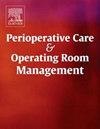麻醉后护理病房患者术后疼痛控制:一项前瞻性观察研究
IF 1
Q2 Nursing
Perioperative Care and Operating Room Management
Pub Date : 2025-04-10
DOI:10.1016/j.pcorm.2025.100490
引用次数: 0
摘要
目的分析麻醉后护理病房患者的术后疼痛控制情况。方法本前瞻性观察研究在巴西米纳斯吉拉斯州的一所大学医院进行。术前、术中和麻醉恢复健康信息被认为与术后疼痛控制有关。从麻醉后护理病房入院到出院,采用口头数字量表(VNS, 0-10分)测量疼痛水平。疼痛管理指数(PMI, -3到3分)评估疼痛管理的充分性。描述性统计和有序回归模型确定了相关因素,p值<;0.05认为显著。研究结果样本包括226例患者。入院时,5.8%的患者报告中至重度疼痛(VNS≥4),根据PMI, 85.4%的患者(PMI≥0)的疼痛得到了充分的治疗,但在出院时,22.1%的患者报告中至重度疼痛(VNS≥4),回归分析显示疼痛管理不足(OR = 9.97, p <;0.01)和焦虑或抑郁的存在(or = 3.89, p <;0.01)显著增加了经历更高程度疼痛的几率。焦虑和抑郁共存与高水平疼痛的高风险相关(OR = 9.29, p <;0.01)。另一方面,年龄(年龄较大)是保护因素(OR = 0.97, p = 0.046)。结论我们的研究发现,相当比例的患者有中度至重度的术后疼痛。本研究的结果可能有助于对具有本研究确定的危险因素的患者进行更有效的术后护理。本文章由计算机程序翻译,如有差异,请以英文原文为准。
Postoperative pain control in patients in the post-anesthesia care unit: a prospective observational study
Purpose
To analyze postoperative pain control in patients in the post-anesthesia care unit.
Method
This prospective observational study was conducted at a University Hospital in Minas Gerais, Brazil. Preoperative, intraoperative, and anesthesia recovery health information were considered for their association with postoperative pain control. Pain levels were measured using the verbal numeric scale (VNS, 0–10 points) from admission to discharge from the post-anesthesia care unit. The Pain Management Index (PMI, -3 to 3 points) assessed pain management adequacy. Descriptive statistics and an ordinal regression model identified associated factors, with a p-value < 0.05 considered significant.
Findings
The sample consisted of 226 patients. Upon admission to the post-anesthesia care unit, 5.8 % of patients reported moderate to severe pain (VNS ≥ 4). According to PMI, Pain was adequately treated in 85.4 % of patients (PMI ≥ 0). However, at the time of discharge, 22.1 % of patients reported moderate to severe pain (VNS ≥ 4). Regression analysis showed that inadequate pain management (OR = 9.97, p < 0.01) and the presence of anxiety or depression (OR = 3.89, p < 0.01) significantly increased the odds of experiencing higher levels of pain. The coexistence of anxiety and depression was associated with a greater risk of high levels of pain (OR = 9.29, p < 0.01). On the other hand, age (being older) was a protective factor (OR = 0.97, p = 0.046).
Conclusion
Our study found that a significant proportion of patients suffer moderate to severe postoperative pain. The results of this study may contribute to more effective postoperative care for patients with the risk factors identified in this research.
求助全文
通过发布文献求助,成功后即可免费获取论文全文。
去求助
来源期刊

Perioperative Care and Operating Room Management
Nursing-Medical and Surgical Nursing
CiteScore
1.30
自引率
0.00%
发文量
52
审稿时长
56 days
期刊介绍:
The objective of this new online journal is to serve as a multidisciplinary, peer-reviewed source of information related to the administrative, economic, operational, safety, and quality aspects of the ambulatory and in-patient operating room and interventional procedural processes. The journal will provide high-quality information and research findings on operational and system-based approaches to ensure safe, coordinated, and high-value periprocedural care. With the current focus on value in health care it is essential that there is a venue for researchers to publish articles on quality improvement process initiatives, process flow modeling, information management, efficient design, cost improvement, use of novel technologies, and management.
 求助内容:
求助内容: 应助结果提醒方式:
应助结果提醒方式:


